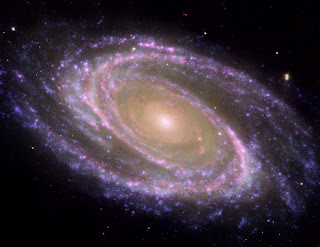 The perfectly picturesque spiral galaxy known as Messier 81, or M81, looks sharp in this new composite from NASA's Spitzer and Hubble space telescopes and NASA's Galaxy Evolution Explorer. M81 is a "grand design" spiral galaxy, which means its elegant arms curl all the way down into its center. It is located about 12 million light-years away in the Ursa Major constellation and is one of the brightest galaxies that can be seen from Earth through telescopes. The colors in this picture represent a trio of light wavelengths: blue is ultraviolet light captured by the Galaxy Evolution Explorer; yellowish white is visible light seen by Hubble; and red is infrared light detected by Spitzer. The blue areas show the hottest, youngest stars, while the reddish-pink denotes lanes of dust that line the spiral arms. The orange center is made up of older stars. Image credit: NASA/JPL-Caltech/ESA/Harvard-Smithsonian CfA | Since Galaxy Zoo's launch in July 2007, some 150,000 members of the public, inspired by the opportunity to be the first to see and classify a galaxy, have helped professional astronomers via this on-line mass-participation project to carry out real scientific research. Two of Galaxy Zoo's founders, Chris Lintott, from the Department of Physics at the University of Oxford, and Kate Land reflect on the project's success in September's Physics World. While there has been a range of computer programs that make use of the idle time of users' PCs to churn through scientific data, like ClimatePrediction.net for modelling global warming, Galaxy Zoo was the first of its kind to engage computer users and ask them to apply their own brain power to help sort one type of galaxy from another. With almost a million galaxy images provided by the robotic Sloan Digital Sky Survey telescope in New Mexico, the Galaxy Zoo team knew it was a tall order. However, even on the day of launch after a small news item on Radio 4's Today programme, the site was receiving more than 70,000 classifications each hour. |
The original impetus for the project was a research dilemma that required a complete reassessment of 50,000 images. Existing criteria used to define elliptical galaxies – colour, density profile and spectral features – appeared to leave out a small fraction of important elliptical galaxies that were undergoing star formation.
The 150,000 amateur astronomers have helped make more than 50 million classifications, thereby helping the researchers obtain a good statistical error for each one. For about a third of the 900,000 galaxies, more than 80 per cent agreed on the morphology which gave the researchers an astoundingly good starting point.
Advances in our understanding of the universe have already been made and a selection of journal articles has already been published. The researchers are now developing Galaxy Zoo to make a more detailed classification of a smaller set of galaxies plus a deliberate search for more unusual objects.
The founders write, "As we develop the citizen science that powers Galaxy Zoo, we can expect many new discoveries to follow. After all, having 150,000 co-authors is an excellent motivator when it comes to writing papers."
Also in this issue:
* Ugo Amaldi, son of Italian physicist Edoardo Amaldi, reflects on his father's remarkable scientific life in particle physics, nuclear physics and gravitational-wave research, as well as his key role in setting up CERN and the European Space Agency.
* The discovery of iron-based high-temperature superconductors has prompted a huge surge of interest in these new materials and rekindled the dream of room-temperature superconductivity. ###
Contact: Joe Winters joseph.winters@iop.org 44-020-747-04815 Institute of Physics












No comments:
Post a Comment